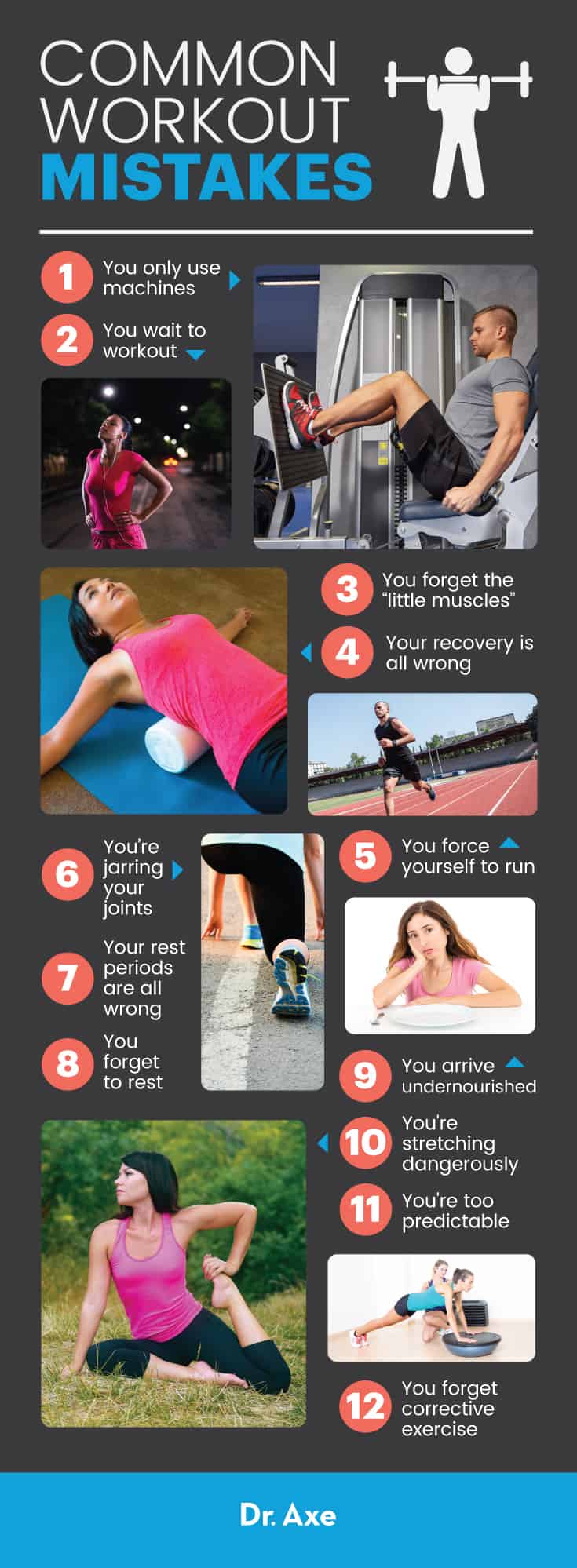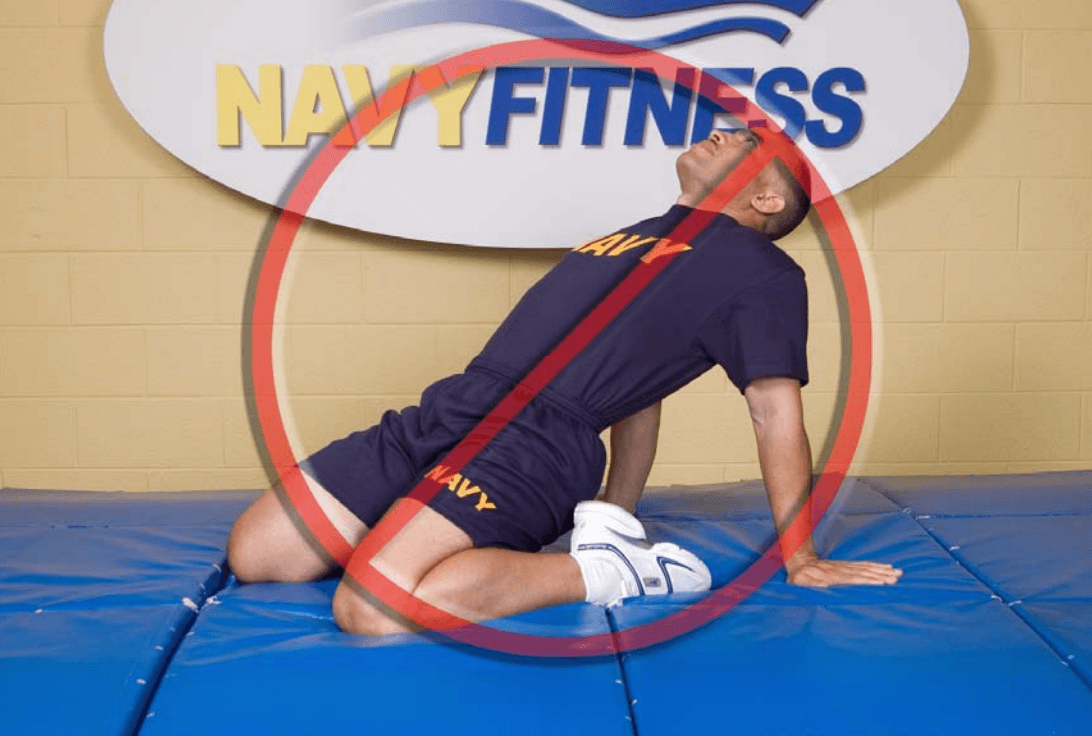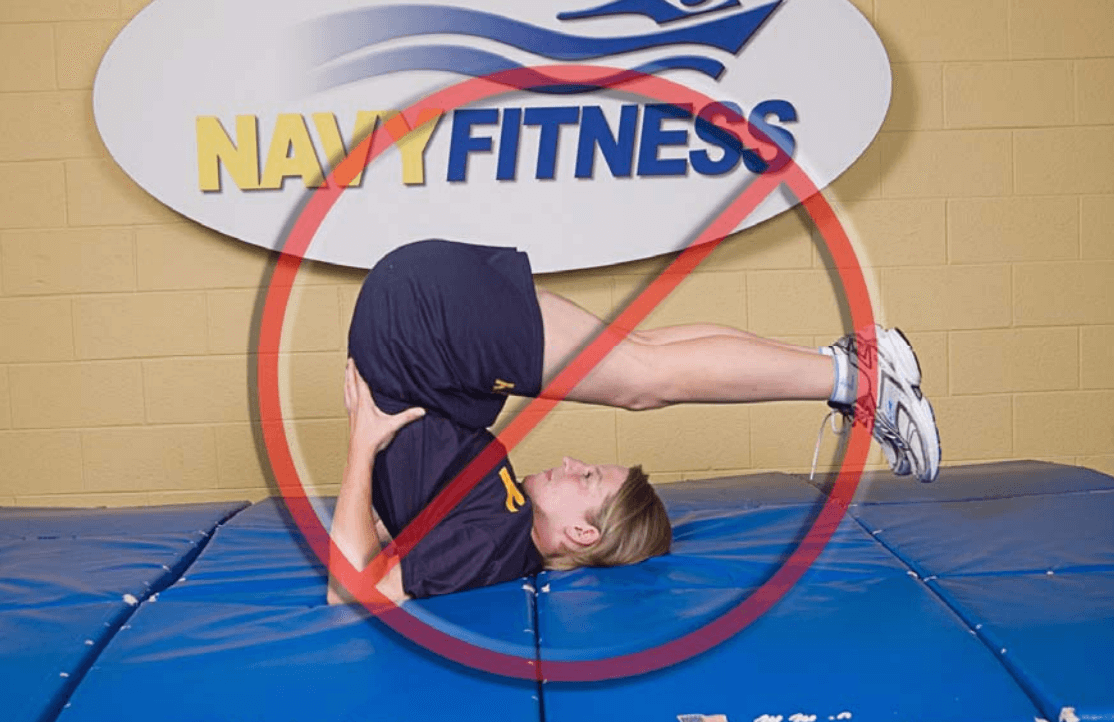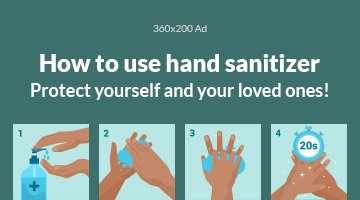Time is precious. That’s why making the most of every sweat session — and avoiding common workout mistakes — is key.
I’m a huge fan of sneaking in mini-workouts whenever I can. That’s one of the benefits of high-intensity interval training: You only need a few minutes.
But there are so many other ways you can shift your exercise routine to more efficient workouts. Tiny tweaks can make a huge different when it comes to losing body fat faster, increasing lean muscle mass and reducing stress.
Here are some of the most common workout mistakes you should avoid …
1. You only use machines
There’s no doubt about it: Resistance training is one of the best things you can do for your body.
Ad
In fact, a 2012 study found just 10 weeks of resistance training can increase lean muscle mass by nearly 4 pounds and reduce 4 pounds of fat while increasing your metabolic rate by 7 percent. Translation: You’ll burn more fat when you’re out of the gym, too.
Strength training does so much more than that, too. It’s a key factor in the natural management of type 2 diabetes, thanks to its ability to help create normal blood sugar levels.
Resistance training also lowers your resting blood pressure, helps shed that dangerous belly fat and increases bone mineral density by 1 percent to 3 percent.
Clearly, we all need to make sure strength training is in our lives.
But you’re short-changing yourself if you’re only using machines. In fact, this is one of the classic workout mistakes.
about:blank
Strength training machines lock your movement into a predetermined plane of motion, meaning you’re working those large, primer mover muscles without much assistance from stabilizing muscles. Keeping these muscles out of the mix fails to strengthen them and also largely eliminates the use of balance in each lift.
Certainly, if your only goal is to increase muscle mass in one area, or if you’re focusing on one muscle group for rehab purposes, machines have their place. However, many of us want more functional training so we can move around with more ease, and in less pain, every day.
Free weights strengthen total-body movements and increase coordination between different muscle groups. They may improve performance better than a machine-only approach, too.
For instance, squats are more effective at increasing vertical jumping compared to machine leg presses.
Be sure to make free weights part of your lifting routine, and don’t forget to incorporate bodyweight exercises, too.
Remember, even the ancient Greeks understood the insane fitness value of calisthenics.
2. You wait to work out
Certainly, working out at night is better than not working out at all, but studies show you can optimize your workouts by targeting a specific time of day, depending on your goals. (Of course, pushing your workout to nights also means more excuses can pop up during the day, derailing your p.m. workout efforts, too.)
The best time to sneak in a sweat session largely depends on your main fitness goal.
- Walking to lose weight? Getting your steps in during evening hours versus the morning can transform your diet in a way that better leads to weight loss, according to a 2011 study published in the Journal of Sports Medicine and Physical Fitness. Walking later in the day prompted exercisers to eat more during breakfast, an important factor to reduce late-night cravings, lower the risk of obesity and improve weight-loss success.
- You can also optimize fat-burning if you work out in a fasted state before breakfast. Doing this helps improve insulin sensitivity even if you eat a high-fat diet, researchers say. The good news for walkers? You’ve got options.
- If you’re looking to build muscle fast and increase strength, evening workouts may be more optimal.
- To beat workday brain fog and increase focus and performance, aim for afternoon sweat sessions between noon and 6 p.m.
- Exercise is one of the most potent stress relievers on the planet. To help prime your blood pressure for optimal levels for sleep, opt for morning exercise. A study by Appalachian State University researchers found morning resistance training helped drop blood pressure levels by 20 percent on average. That’s as good or even better than common hypertension-fighting drugs.
3. You forget the “little muscles”
Sure, biceps, pecs and quads usually get all of the glory, but there’s more to movement than those big “prime mover” showoff muscles. There’s a whole other cast of characters you need to nurture.
Stabilizers are muscles that support the body while the prime movers do their thing. Synergists help assist those prime movers to create functional movement patterns.
Ad
If you ignore these “little guys,” you could be setting yourself up for posture problems that can manifest into pain and injuries down the line.
Workout mistakes like these will only snowball and lead to inflammation, pain, altered movements and eventually injury.
Using resistance band exercises and other exercises that involve multiple planes of motion that mimic more real-life movements (not just the up-and-down of a bicep curl) can help target those important, albeit less famous, muscles.
Target the dynamic stabilizers of the rotator cuff, erector spinae (deep core muscles that keep your body upright), gluteus medius and minimum, tibialis anterior, and obliques.
You can strengthen some of these important muscles by performing the following exercises:
- Back extensions
- Bicycle crunches
- Side steps with an exercise band around both feet
4. Your recovery is all wrong
If your post-workout recovery consists of 2 minutes of stretching and a shower, it’s time to get real.
Workout mistakes like these may not seem like a big deal now, but as you age you’ll start feeling it. Chances are it’ll catch up with your joints and muscles as you age, making injury and pain inevitable.
Here, I want to specifically cover foam rolling exercises.
But let’s back up a second.
The organs, muscles, nerves, bones, arteries and veins of your body are all enveloped in a densely woven webbing called fascia. Much like the yarn of a sweater, your fascia connects your entire inner body, highlighting the fact that trouble in one spot could impact a totally different part of the body.
When you work your muscles hard, microspasms occur, triggering the formation of “knots” or adhesions in the soft tissue. This, in turn, starts leading to abnormal movement that can, over time, result in chronic pain and injury.
Luckily, self-myofascial release, including foam rolling, can help “break up” those knots to help get your muscle length and functioning back to normal.
Here’s the big takeaway: Foam rolling short, tight muscles riddled with knots in combination with proper stretching can help return your body to a more normal range of motion. This can improve not only performance, but just how you feel in general, too.
A Texas Woman’s University study found this combo can serve as one of the remedies for fast back pain relief.
And this is something I’m really excited about: Foam rolling affects your brain and stress hormones, too — not just your muscles.
Emerging science now suggests foam rolling impacts the nervous system and can actually lower cortisol levels, reducing not just physical stress, but emotional stress, too. In fact, foam rolling can improve cortisol levels after exercise better than rest alone. Exciting stuff!
To get a full-spectrum foam rolling and corrective exercise program, your best bet is to have an overhead squat and other posture and movement assessments through a qualified personal trainer with high-level certifications and a college degree to do so. The National Academy of Sports Medicine focuses heavily on these assessments and corrective exercise programs.
A few key points:
- Common muscles to focus on with foam rolling include the calves, peroneals, IT band, TFL, piriformis, adductors, hamstrings, quadriceps, latissimus dorsi and thoracic spine.
- You can foam roll 1 set daily, holding tender spots for 30 to 90 seconds.
- Do NOT make the classic foam rolling workout mistakes of just quickly rolling over a muscle back and forth. You need to hold tender spots so the muscular, skeletal and neural systems can work together to more effectively break up the adhesion.
- To improve flexibility, follow foam rolling with static stretches of the same muscles, holding the static stretches for at least 30 seconds. Do this before and after a workout.
- Keep proper posture as you’re rolling.
- If you want more pressure, you can use your own body to create it. For instance, if you’re rolling your calves and need more pressure, you can cross your one leg over the other that’s being rolled.
- If you have a health condition or are pregnant, check with your doctor before foam rolling. Foam rolling is often not suitable for people with uncontrolled high blood pressure, congestive heart failure or other organ failure, skin lesions, goiters, cancer, blood clots, bleeding disorders, and certain other health issues.
5. You force yourself to run
If you’ve gone over the best running tips for beginners and still dread lacing up your sneaks for a jog, it may be time to find another form of cardio. The key is to do something you like so you stick with it, not torture yourself.
If you do stick with running, remember, it’s not all about speed. In fact, people who run slower tend to live longer. Fast marathon runners actually gain no increase in life span compared to people who avoid all exercise, according to research.
Cycling, mountain biking and spinning (I love the Peloton bike) are just a few of the other ways to work cardio into your life. Swimming is another option.
Just make it fun, and find a workout buddy.
We know working out with a buddy increases your odds of sticking to an exercise routine, but did you know a virtual buddy works, too? That may be one huge factor in Peloton’s success, where people from all over the world indoor cycle as they’re connected virtually to other riders.
6. You’re jarring your joints (and maybe your lungs)
Love basketball? Opt for indoor instead of a game on asphalt to save your knees.
Runner? Get your jog on along the side of the road for more give, and consider trail running for a more natural, less jarring surface. Runner’s World’s annual sneaker guide features many options with better shock absorption, but shoes can only go so far.
Beware of other popular workouts linked to joint injuries.
They dynamic, twisting movements of Zumba make it not just a fun class, but one that could damage your joints. In one study, nearly 30 percent of Zumba participants experienced injuries, and 42 percent of those involved the knee.
The people most likely to suffer injury took class nearly four times a week, so if your joints are feeling it, maybe dial back a bit and fill in a class or two with something more forgiving, like gentle yoga. (Make sure you have a qualified instructor.)
Flooring matters, too. For indoor gyms, I prefer flooring made out of natural cork or real linoleum (NOT vinyl knockoffs).
This brings up an important side point: Natural floorings like solid or certified formaldehyde-free manufactured cork don’t give off gas toxic fumes common to popular gym flooring and mats.
In 2014, the University of Lisbon in Portugal and the Delft University of Technology in the Netherlands released first-of-its-kind data showing the horrific state of indoor air in gyms. We know vinyl-based products off-gas carcinogenic formaldehyde, as well as plasticizing phthalate chemicals.
Popular gym flooring made of recycled tires labeled as “rubber” is often laden with compounds on the verge of being classified as hazardous waste. Tire “crumb” used in many gym floors contains distillate aromatic extract, oils that can make up to 30 percent of a tire’s mass.
Unfortunately, these are among the world’s most harmful chemicals, rich in polyaromatic hydrocarbons and other carcinogens, according to the Healthy Building Network.
Urge your gym to use healthier flooring materials, and invest in an air exchange system. If you’re setting up a part of your home for working out, look into cork or real linoleum flooring with good shock absorption qualities.

7. Your workout rest periods are all wrong
The amount of time you rest between exercise sets really matters, depending on your fitness goals.
Here’s a nice breakdown from the National Academy of Sports Medicine:
- Muscle endurance and stabilization: This is great if you’re just getting started or back on the wagon with exercise. It’ll help strengthen key muscles for joint stability so you can build a strong foundation and progress in a safer way as you become more fit. In this stage, you’ll focus on lifting lighter and taking a rest period anywhere from zero to 90 seconds long between sets. The short rest period keeps the heart rate elevated, optimizing fat burn and weight loss.
- When hypertrophy is the goal, we’re focusing on increased muscle size. Relatively short rest periods increases human growth hormone and testosterone levels, particularly in men. It’s is best achieved with relatively short rests periods often ranging from 0 to 60 seconds. Longer rest periods may be appropriate depending on the amount of weight lifted and condition of the lifter.
- Maximal strength and power: When you’re focusing on lifting your max weight and when you’re training for maximum power, you’re going to focus on taking much longer rest periods. Generally, three to five minutes are necessary.
8. You forget to rest altogether
Overtraining is a problem, too. Not giving your body and hormones the time to adjust to exercise — or not resting adequately between workouts — can cause injuries, mood problems, negative changes in your metabolism and “burnout” within a couple of months’ time.
While too much exercise alone might not be the sole reason for negative symptoms in some people, overtraining combined with stress from other factors like imbalanced hormones, a poor diet, and a lack of rest or sleep can all accumulate to serious bodily damage.
And get this: Overtraining can actually cause weight gain. Excessive exercise can lead to chronically high cortisol levels, which can switch your body into fat-storage mode.
Signs of overtraining include:
- Changes in your heart rate
- Trouble sleeping
- Increased soreness
- Joint pain
- Moodiness, anxiety or depression
- Chronic fatigue or exhaustion
- Changes in your appetite
- Feeling more thirsty than usual
- Digestion issues
- Irregular periods or changes to your menstrual cycle, such as with the severe overtraining phenomenon called female athlete triad
Running is definitely an exercise that helps you live longer, but you’ll want to mix it up to include the benefits of yoga and HIIT training, too.
9. You arrive undernourished
Working out on an empty stomach does burn fat, but showing up with an empty tank doesn’t work for everyone. In fact, having the right pre-workout snack actually enhances fat burn in some.
If you find yourself burning out halfway through your workout, you may want to try some of these pre-workout snacks before you hit the gym.
A study published in the Journal of the International Society of Sports Nutrition found no difference in weight loss between women who ate a meal replacement shake before exercising and those who got straight into their workouts without eating.
So the moral of the story? Do what’s right for you, but probably get some sort of natural, pre-workout drink or snack into your routine.
10. You’re stretching dangerously
This is a biggie when it comes to workout mistakes. If you played sports growing up, chances are you did one of these dangerous stretches that place unnecessary strain and torque on your joints.
Common Exercise Mistake: You Endanger Your Knee with This Hurdler’s Stretch

Photo: Navy Fitness
The above hurdler’s stretch is designed to stretch the hamstring, but it’s one of the major workout mistakes.
The problem lies in that left knee. See how it’s rotated and stressing the knee?
This can stretch ligaments and the joint capsule, damaging cartilage, according to many studies. The U.S. Navy IDs this as a stretch to avoid.
To get a hamstring stretch without the unneeded stress, put the foot of the leg opposite the one being stretched to the inner thigh of the stretched leg.
Common Exercise Mistake: You Do This Quadriceps Stretch with Both Knees Flexed

Photo: Navy Fitness
Here’s another one that stresses your knees. You can get an effective quad stretch without the damaging effects of the one above.
Instead, the Navy trainers recommend lying on your stomach, then reaching around with one arm and grasping the same-side foot. Gently pull the foot toward the buttocks until you feel a stretch in the front of the leg.
To protect your neck, turn your head toward the same side that you’re reaching.
Exercise Mistake: You Do This Overhead Bicycle, Yoga Plow Stretch

Photo: Navy Fitness
This may be the most dangerous stretch on the list, and there’s no safe alternative. It places your neck into extreme forward positions, putting pressure on the cervical discs.
11. You’re too predictable
Whenever we do anything without any variation, we can get bored, and our fitness goals can plateau. The nervous system and muscle can adapt to your routine, sometimes as early as 6 to 8 weeks.
Now it’s time to shake things up!
Here are a few tricks for climbing your way out of a plateau so you don’t get stuck in this workout mistake:
- If you’re a runner, try the Swedish training trick called fartlek.
- Trade in a few longer, moderate cardio workouts for BurstFit ideas you can do at home.
- Eliminate or drastically cut back on alcohol. I’ve seen so many people fall off of the fitness wagon, sometimes with as little as one or two drinks. If you’re drinking and hitting a plateau, it’s time for mocktails instead.
- Eat more fat. That’s right, your body may be craving more healthy fats. Experiment with your calorie intake, and see if adding more avocados and other healthy fats into your diet stokes your fat burn again.
12. You forget corrective exercise
We touched on foam rolling earlier, but that’s just one important component of corrective exercise. To work out without this critical component is making one of the most common workouts mistakes.
To get a personalized read on what you need to work on, it’s best to consult with a certified personal trainer. (I recommend ones through National Academy of Sports Medicine, the American College of Sports Medicine or the National Sports and Conditioning Association.)
Chiropractors and physical therapists can also help.
The idea is getting a postural and movement assessment that will help show:
- Muscles that need rolling and stretching
- Muscles that need strengthening
- Running issues like pronation or supination
- Broken body mechanics, including postural distortions like forward head posture, as well as upper- and lower-crossed syndrome
Final Thoughts
- The best time of day to exercise depends on your specific fitness and health goals.
- To avoid injury and pain, it’s imperative to work corrective exercise into your routine and avoid common workout mistakes.
- Foam rolling can improve both your physical and mental stress levels, but you have to roll the right muscles and be sure to hold tender spots for at least 30 to 90 seconds to be effective.
- If you’re starting to notice joint pain, pay attention to the classes you take, your shoes and the surfaces you exercise on. Workout mistakes are usually the culprit, and adjustments may be necessary.
- The rest period you take in between exercise sets varies depending on your fitness level and goals.





